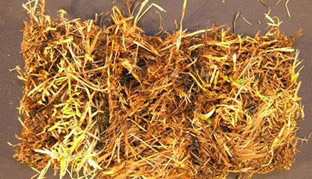Arkansas Plant Health Clinic Disease Notes
Contact
Plant Diagnostician
Phone: (479) 575-2727
Email: ssmith@uada.edu
Jason Pavel
Diagnostician
Phone: (479) 575-7257
Email: jpavel@uada.edu
University of Arkansas System Division of Agriculture
Cralley Warren Building
Room 16
2601 N. Young Ave.
Fayetteville, AR 72704
Turf Pythium
by Sherrie Smith and Jason Pavel
Plant Health Clinic Disease Note Issue 8

Pythium Blight-Pythium sp. (Photo by Sherrie Smith, University of Arkansas System Cooperative Extension)
With all the wet weather we are seeing Pythium disease in our turf samples. The disease may occur in cool, wet weather, but the most obvious damage occurs in hot, humid weather. All species of turf are susceptible.
In cool weather, blighted leaves have straw- colored lesions. Characteristic sporangia and oospores may be observed when viewed under a compound microscope. In warm, wet weather, Pythium begins as circular spots 2-6 inches in diameter. They can enlarge at an alarming rate, sometimes destroying a stand of grass in a day. The areas may be copper or straw colored, or have a gray, water-soaked appearance. The water-soaked leaves feel greasy when rubbed between the fingers, leading to the common name Grease spot. Leaves become shriveled and matted when dry.
During wet periods or periods of high humidity, the affected leaves become covered with a fluffy, white, or gray mass of mycelia. Sometimes the blighted turf occurs in patches or circles with an area of green turf in the center.
How do I prevent pythium turf disease?
Pythium disease can only occur in areas that remain wet for extended periods. Provide good surface and subsurface drainage. Avoid overwatering and night watering. Thatch removal is recommended if thatch exceeds half an inch in depth. Reducing plant stress with proper mowing heights and fertilization helps control Pythium diseases. Avoid over-fertilization with nitrogen, and heavy applications of nitrogen in spring and summer. Slow-release nitrogen fertilizer gives better results. Disease is more severe on soils with high pH.
How do I get rid of pythium turf disease?
Fungicides such as Terrazole, Subdue Maxx, Mancozeb, Alude, junction, Stellar, and Banol are labeled for the control of Pythium in turf. Homeowners may also use Actinovate.
Take Aways:
- Do not overwater turf.
- Avoid too much nitrogen fertilizer.
- Remedy high pH.
- Apply fungicides.
Follow us on Facebook!
This work is supported by the Crop Protection and Pest Management Program [grant no. 2017-70006- 27279/project accession no. 1013890] from the USDA National Institute of Food and Agriculture.